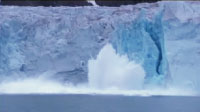 |
NASA | GSFC | JPL | Site Map |
|
|
 |
 |
Education: Student Outcomes |
Click here to search for other assets Melting Ice, Rising Seas: Global Warming & Ocean Change Grade level: 9-12 Themes: climate, ocean circulation, water cycle Video: melting_ice_01.flv
Josh Willis: "I prefer not to think about climate change and global warming in terms of doom and gloom scenarios, so much as a change in our planet. Our planet's definitely changing, and we're definitely causing it. So we're going to have learn to deal with some of these changes. But in addition, we're going to have to learn how to make a slightly smaller footprint on our planet." Josh Willis: "Sea level is rising effectively because of global warming. As the planet heats up, two things happen to the ocean. One is that the temperature of the water increases. And as that happens, the water actually expands and takes up more room. The other thing that happens is that ice that was on land in the form of glaciers and ice sheets begins to melt and as that runs off into the ocean, it increases the water in the ocean, and it actually raises sea level as well. (source) Student Outcomes After viewing this video, students should be able to: Describe how changes in the ocean's circulation can produce large changes in climate. (C: 9-12) Explain the relationship between fresh water and ocean dynamics. (W: 9-12) Determine if global precipitation, evaporation, and the cycling of water are changing. (W: 9-12) Key: C = climate / O = ocean circulation / T = 21st century technology / W = water cycle |
|||||
